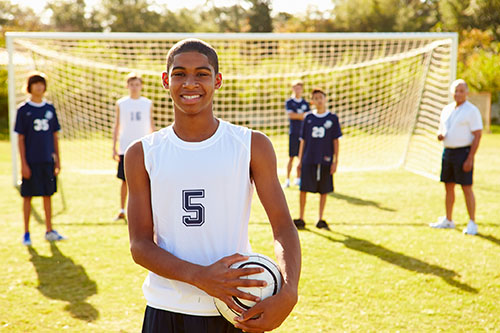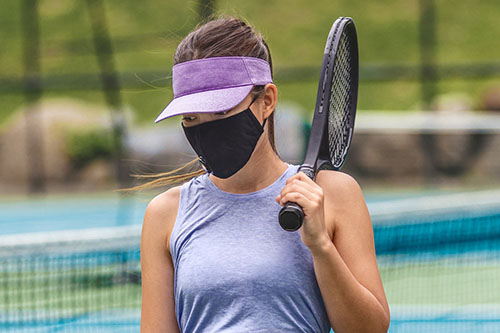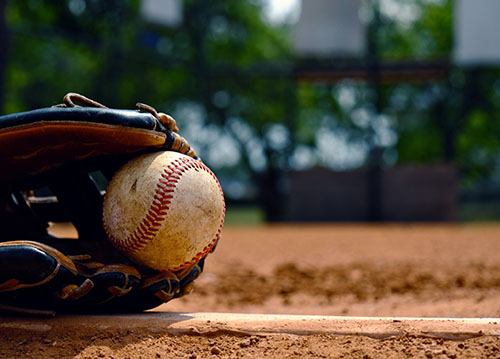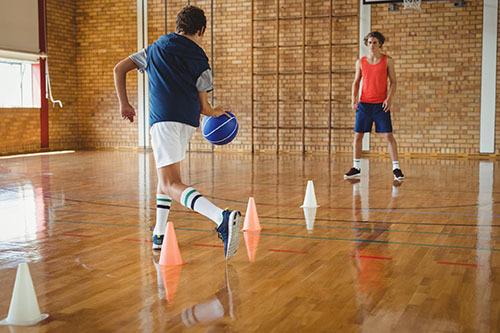Playing Sports
What you need to know
- Stay home if you have tested positive for COVID-19 or are waiting on test results, are showing COVID-19 symptoms, or have had a close contact with a person who has tested positive for or who has symptoms of COVID-19.
- Bring your own equipment, like gloves, head gear, helmets, water bottles, and bats, if possible, to limit shared equipment.
- Stay at least 6 feet (about 2 arm lengths) from other players when possible.
- Wear a mask that covers your nose and mouth to help protect yourself and others.
- Clean or sanitize your hands before and after practices, games, and sharing equipment.
- Tell a coach or staff member if you don’t feel well.
This information is for youth and adult athletes considering participating in a sports league or team.
This information is not designed to provide guidance to adult sports leagues or organizations who plan or manage competition. CDC does not currently have guidance for adult sports leagues, however organizations and administrators can reference the Considerations for Youth Sports to find strategies for reducing exposure risks during sports competition.
Make a game plan to reduce risk
There is an increased risk of COVID-19 spread while playing team sports. There are ways to reduce this risk:
- Setting: choose outdoor settings as much as possible, particularly for high intensity activities.
- Proximity: maintain at least 6 feet of separation (about 2 arm lengths) and avoid close contact with other people.
- Field of play: try to choose a larger playing area so that you can spread out from each other.
- Mask use: wear a mask that covers your mouth and nose at all times.
- Exertion level: limit high-intensity activities to the outdoors.
- Travel: limit travel required outside of the local community.
- Ventilation: look for facilities that have high ceilings and use ventilation practices such as opening doors and windows and use portable air cleaners that have HEPA filters.
- Frequently touched surfaces and shared equipment or gear: wipe off frequently touched surfaces, equipment, or gear with disinfecting wipes before and after use.
- Clean hands: wash your hands with soap and water for 20 seconds or use hand sanitizer with at least 60% alcohol before and after using machines.
- Number of people: limit how many individuals you interact with.
- Duration: if choosing to stay indoors, keep your activities as brief as possible to avoid prolonged exposure.

Prepare before you participate in sports
- Bring extra masks and hand sanitizer with at least 60% alcohol.
- Prioritize participating in outdoor activities over indoor activities and stay within your local area as much as possible.
- If using an indoor facility, allow previous groups to leave the facility before entering with your team. If possible, allow time for cleaning and/or disinfecting.
- Check the league’s COVID-19 prevention practices before you go to make sure they have steps in place to prevent the spread of the virus.
- If you are at an increased risk for severe illness or have existing health conditions, take extra precautions and preventive actions during the activity or choose individual or at-home activities.
Take steps to protect yourself and others
Know your teammates
- What your teammates do off the field is as important as what they do on the field. If they are attending gatherings without masks or physical distancing, going to bars or restaurants, etc., that puts the whole team at risk.
Advice for parents
- Help your athlete follow mitigation measures off the field. What one athlete does at home or off the field can impact the entire team.
- Talk to your child’s coach and let them know you support all measures to slow the spread of COVID-19. These can include practicing outside instead of inside, limiting attendance at practices and games, and requiring masks of athletes, coaches, and visitors.
Stay home if sick
- If you have symptoms of COVID-19, have been diagnosed with COVID-19, are waiting for COVID-19 test results, or may have been exposed to someone with COVID-19, you should stay home and not participate in any sports.
Have smaller team sizes
- Sports with a large number of players on a team may increase the likelihood of spread compared to sports with fewer team members.
- Limit your team to a core group of participants, by restricting non-team players from joining when your team is short players and not adding new members during the season.
- Maintain careful rosters of which players, family members, coaches, and ancillary staff attend each practice and game, and have current contact information for everyone. If a COVID-19 exposure occurs, timely notifications are critical, and this information will help contact tracing activities occur more smoothly.

Keep space between players in practice areas
Reduce physical closeness between players, volunteers, and spectators when possible
- Maintain at least 6 feet between yourself and your teammates, other competitors, and officials while actively participating in the sport.
- Focus on building individual skills, like batting, dribbling, kicking, and strength training.
- Avoid high fives, handshakes, fist bumps or hugs.
- Keep space between players in the practice areas, including on the sideline, dugout, and bench.
- Wait in car or away from the playing area until just before the warm-up period or the beginning of the game.
- Avoid congregating in the parking lot or near the field before or after games.
- If it is not possible to avoid congregating, practice physical distancing by ensuring there is at least 6 feet between participants.
- Wear a mask over your nose and mouth to reduce risk of virus transmission.
- Limit nonessential visitors, spectators, and volunteers. Ensure they wear masks and maintain physical distancing.
Wear a mask

Wear masks when able
- Wear a mask if feasible, especially when it is difficult to stay less than 6 feet apart from other people and especially indoors, for example in close contact sports such as basketball.
- Lower-intensity sports: Emphasize wearing masks, limiting physical contact, taking extra precautions with shared equipment, and practicing physical distancing for lower intensity sports.
- Higher-intensity sports: Limit high-intensity sports when indoors. People who are engaged in high-intensity activities, like running, may not be able to wear a mask if it causes difficulty breathing.
- Increase distance for high-intensity activities.
- If unable to wear a mask, consider conducting the activity in a location with greater ventilation and air exchange (for instance, outdoors versus indoors) and where it is possible to maintain physical distance from others.
- If your mask gets wet, be sure to change it as it may be more difficult to breathe through.
- CDC does NOT recommend the use of face shields or goggles as a substitute for masks, however they may be used as eye protection in addition to the use of a mask.
Minimize sharing of equipment or gear. Don’t share food or drinks.

Encourage players to bring their own equipment
- Encourage players to bring their own equipment if possible, like gloves, balls, and helmets.
- Bring your own water to minimize use and touching of drinking fountains. Consider labeling your water battle with your name.
- Clean and disinfect shared items between use.
- Don’t share towels, clothing, or any items used to wipe your face or hands.
- Avoid sharing food, drink containers (e.g., coolers), and utensils.
Cover your coughs and sneezes. Don’t spit.
- Cover your cough or sneeze with a tissue. Used tissues should be thrown away and hands washed immediately with soap and water for at least 20 seconds or use hand sanitizer with at least 60% alcohol.
Wash hands
- Wash your hands with soap and water for at least 20 seconds or use hand sanitizer with 60% alcohol.
- Before and after you play.
- Before adjusting your mask—review information about proper use, removal, and washing of masks.
Limit travel outside of your area
- Consider competing against teams in your local area (neighborhood, town, or community).
Advice for coaches
- Send a welcome email or call parents (for youth players) and/or players.
- Inform them about actions that the sports program will take to protect players.
- Remind them to stay home if they are sick, have symptoms of COVID-19, have tested positive for COVID-19 or are waiting for test results, or if they have been around someone who is sick or who has symptoms of COVID-19.
- Be a role model. Wear a mask that fits snugly against the sides of your face and covers your mouth and nose and encourage family members, fans, officials, and sports staff to wear one during practices and games.
- Provide hand sanitizer with at least 60% alcohol to players before and after practice/game.
- Educate players about covering coughs and sneezes with a tissue. Discourage spitting.
- Remind players about physical distancing and identify markers (such as signage or tape on floor) that indicate a distance of at least 6 feet.
- At practice, focus on building players’ individual skills and cardiovascular conditioning, so they can limit close contact with one another.
- Check with your sports administrator to make sure they are following cleaning and disinfection recommendations.
- Clean and disinfect frequently touched surfaces on field, court, or play surface (such as drinking fountains) at least daily and shared equipment (for example, mats) between use.
Checklist for coaches
- Send a welcome email or call parents (for youth players) and/or players. Inform them about actions that the sports program will take to protect players. Remind them to stay home if sick or if they have been around someone who is sick.
- Be a role model. Wear a mask and encourage family members, fans, officials, and sports staff to wear one during practices and games.
- Provide hand sanitizer with at least 60% alcohol to players before and after practice/game and encourage them to wash their hands with soap and water.
- Educate players about covering coughs and sneezes with a tissue or their elbow. Discourage spitting.

Encourage players to focus on building individual skills
- Remind players about social distancing and identify markers (such as signage or tape on floor).
- Encourage your players to focus on building their individual skills and cardiovascular conditioning, so they can limit close contact with other players.
- Check with your sports administrator to make sure they are following cleaning and disinfection recommendations.
- Clean and disinfect frequently touched surfaces on field, court, or play surface (such as drinking fountains) at least daily or between use.
- Clean and disinfect shared equipment.


